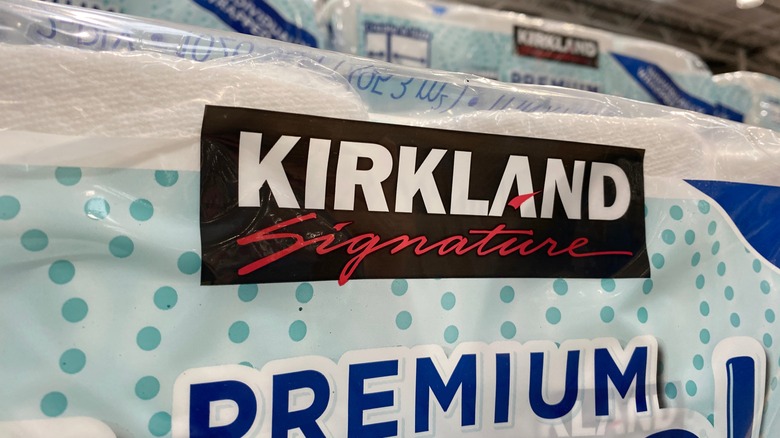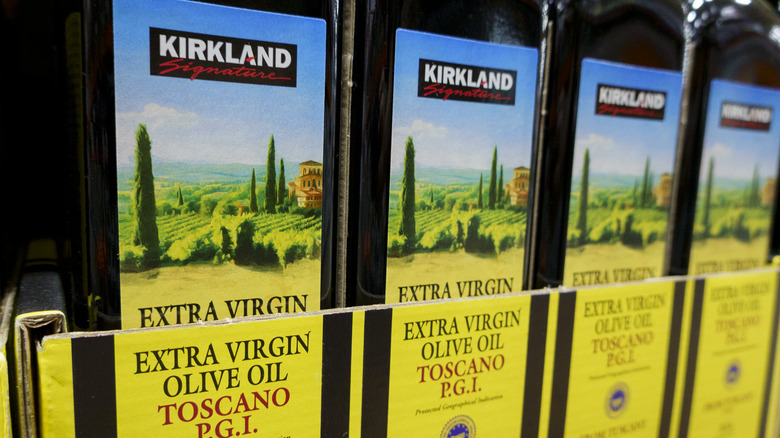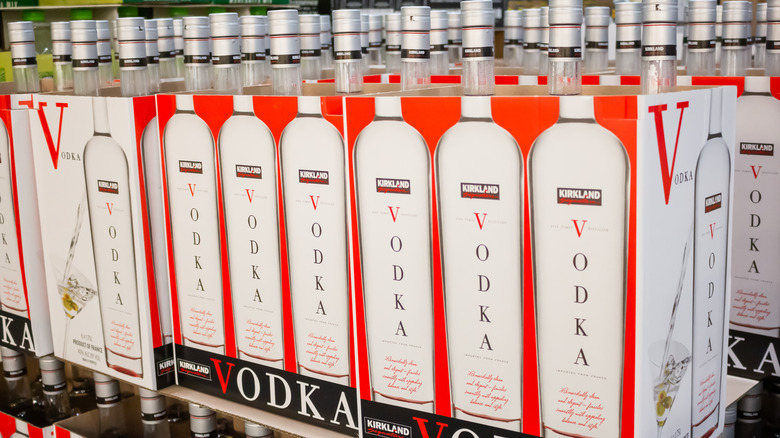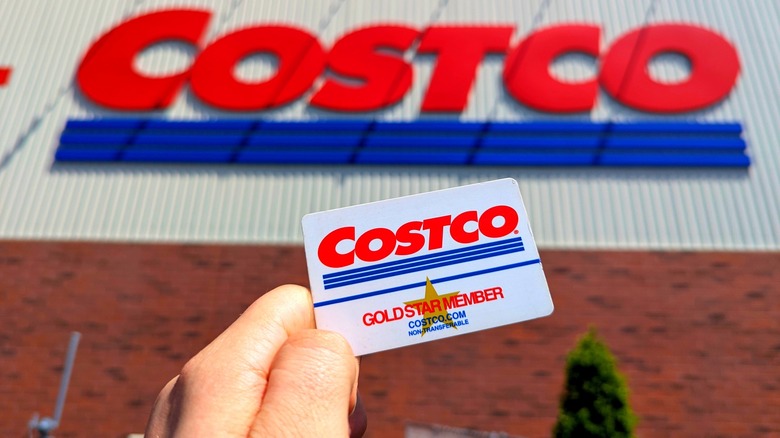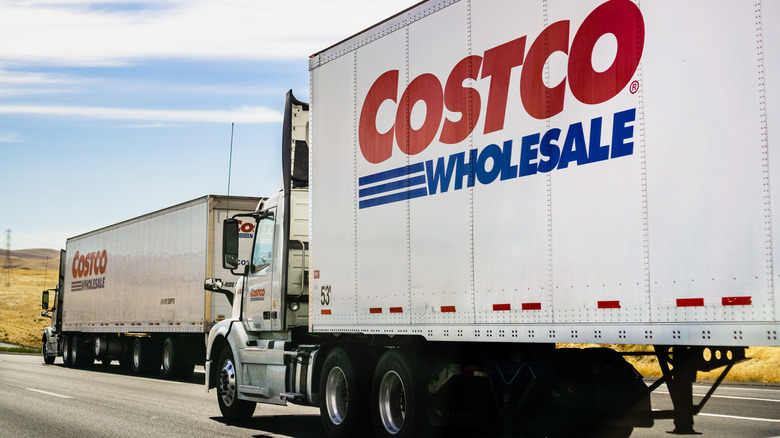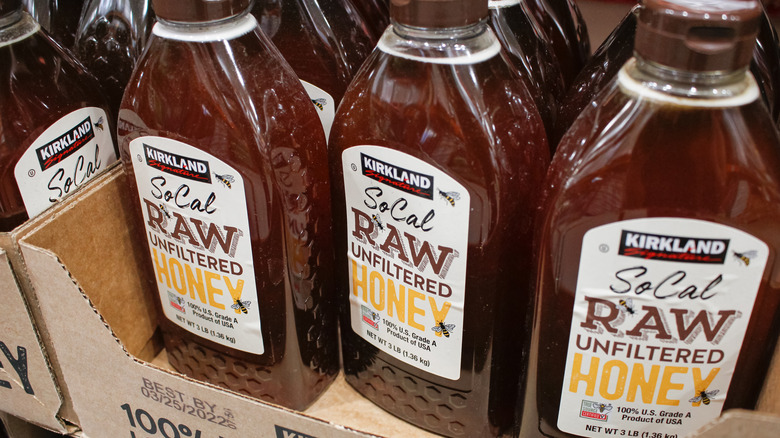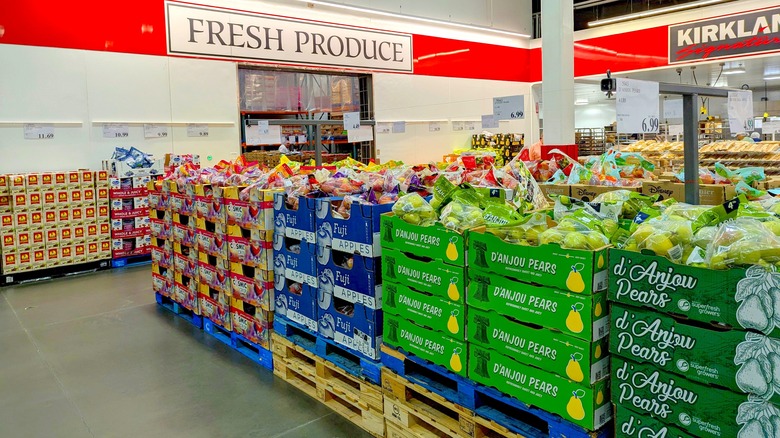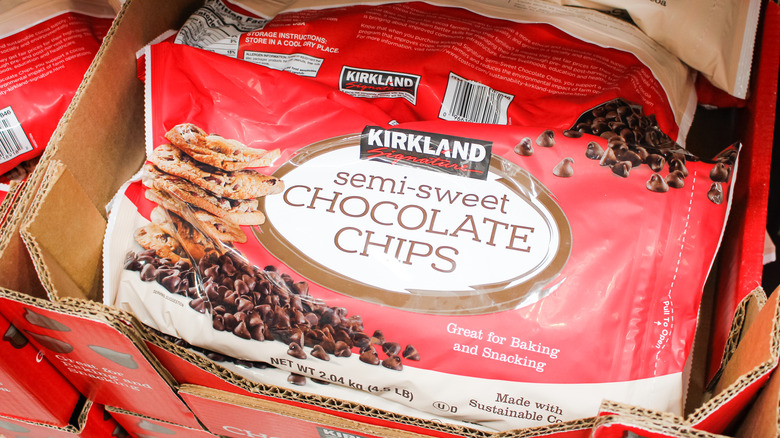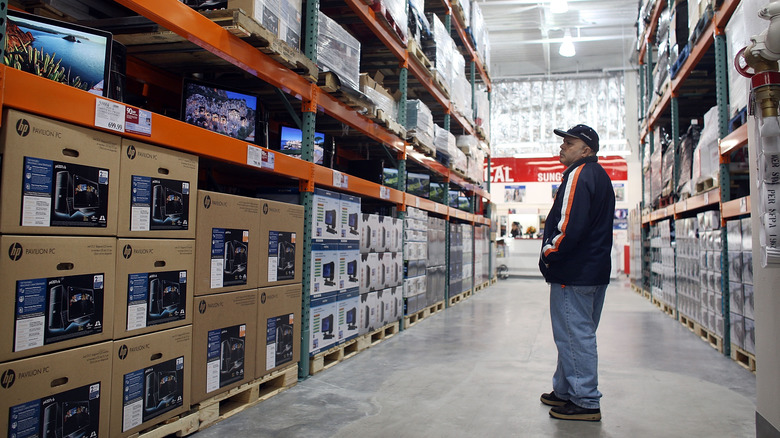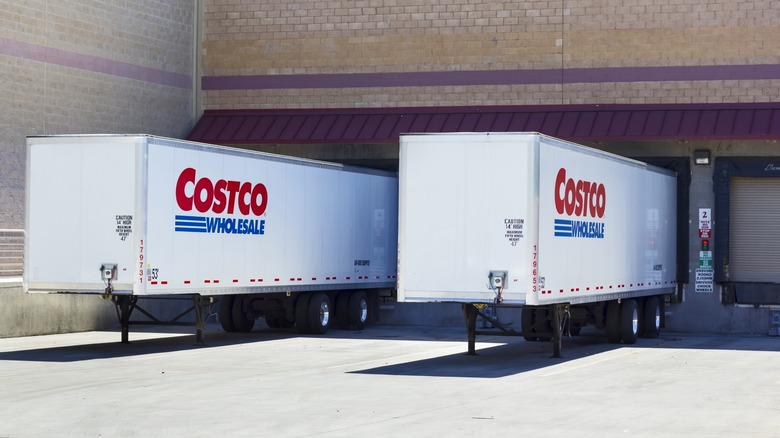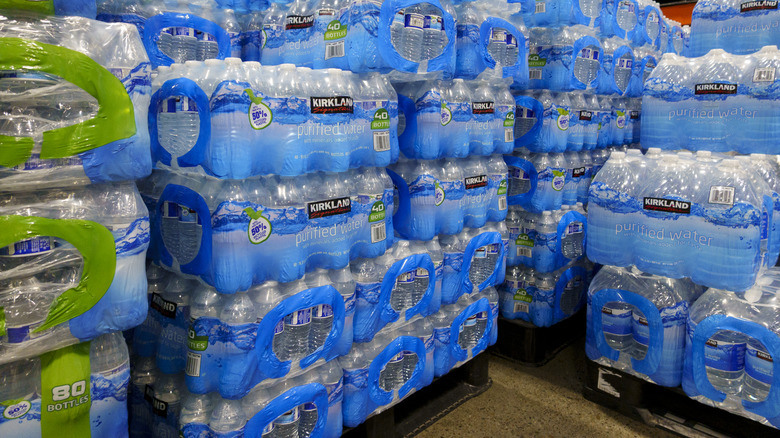We Finally Know How Costco's Kirkland Signature Prices Remain Affordable
It's no secret that many big-box chains have been having a tough go of it under prevailing inflationary pressure. Not Costco, though. The wholesale mega chain posted net sales of $249.6 billion in 2024, up about 5% from 2023, marking yet another year in a streak of steady growth dating back as far as 2021, per Costco.
These impressive numbers are driven in part, if not exclusively, by Kirkland Signature, Costco's in-house brand that now tots nearly 400 products, spanning everything from tissue paper to gasoline. With Kirkland carrying the store's profitability almost solely on its back, you'd think that its price points would inch closer to, if not above, name-brand equivalents.
Although there are a few items that might see price bumps in the coming months, Kirkland price points remain famously pocket-friendly, consistently undercutting name-brand equivalents on value. Even big-ticket Kirkland-brand items that some might say fall under the ridiculously expensive category still retail far below standard market rates, with markups never exceeding Costco's 15% set point. So what's the magic pill that keeps Kirkland seemingly immune to the markup bug? Let's dig into all the reasons Costco's Kirkland Signature line remains exceptionally profitable despite rock-bottom price points.
Kirkland Signature items don't carry brand premiums
A huge reason why Costco can afford to hard cap its markups on Kirkland goods at a modest 15% is because they don't incur brand premiums like marketing, advertising, and promotions. Elaborate marketing is de rigueur for name brands since they likely won't get a retailer to stock them if customers don't know enough about the brand to buy it.
However, by virtue of being an in-house brand, Kirkland wares already have the right to be on the shelves, so they don't need a multi-million-dollar promotional campaign to stir up enough demand for them to make it to retail. Now we know what you're thinking: If they're not incurring marketing overhead, then how do they get the word out about the product? Well, product awareness is rarely ever a problem for Costco, not when there are those all-the-rage free samples to get shoppers talking about the products.
There's also the fact that Costco occasionally stocks, say, $1,000 Cartier watches or luxury bags amid pallets of laundry detergent. That kind of treasure hunt shopping experience encourages customers to browse the aisles, where they get a full picture of Kirkland inventory without having to sit through a flashy super bowl ad. And then there's, of course, word-of-mouth marketing, where customers who've had stellar experiences with Kirkland wares spread the word not only literally, but also on social media channels with broader reach. So it's really no wonder Kirkland rarely has a problem with sell-through.
Sourcing directly from name-brand producers
Granted, being one of the cheapest brands out there is a really huge selling point for Kirkland. But of course, that wouldn't count for much if Kirkland couldn't hold its own against national brands. Shoppers don't necessarily reach for private labels just to score a deal. Quality perception matters, too. That's why Costco sources Kirkland wares from the best of the best, suppliers with proven track records already in bed with premium national brands.
Kirkland house-blend coffee, for instance, is custom-roasted by Starbucks Coffee Company. There's even been rampant speculation that Kirkland Vodka is just dressed-down Grey Goose, which is wild considering Bacardi-owned Grey Goose retails for nearly triple the price. But that's not where the work stops. Selling national brand doppelgängers for a fraction of the price only boosts sell-through on paper. Sometimes shoppers just won't gamble on an unknown product, especially in crowded categories already dominated by one or two heavyweights. So established national brands will always come out ahead against a private label that's just starting to gasp for air.
But Kirkland isn't some obscure private label that nobody cares about. Its products have earned almost cult-like loyalty among Costco members, giving Kirkland the kind of brand power that would have taken years of aggressive traditional marketing to build. With that kind of loyalty, sell-through pretty much takes care of itself. And if cash doesn't constantly get tied up by stale inventory, it won't matter much if you're practically scraping the bottom of the barrel with price points.
Membership fees make up for lost revenue
Grocery stores, even big box chains like Walmart, typically have an open-door policy; anyone can walk in off the street and buy something. Costco wares, on the other hand, are sold exclusively to cardholders. You can't even ride off someone else's membership unless they've explicitly assigned you their free household card. And Costco's pretty ruthless about cracking down on card sharing.
You'd think that shutting out millions — if not billions — of potential customers would hurt revenue. But Costco's invested heavily in building real value around Kirkland. By making access to the brand contingent on membership, it's carved out a secondary revenue stream that can cushion the business against lost revenue. And it does. Membership fees alone churn out billions for Costco, so much that they often overshadow operating profits from product sales. In 2024, for instance, the company's revenue totaled $254.4 billion, per Costco. Of that, sales revenue hit $249.6 billion against operating expenses of about $245.1 billion, leaving operating income sans membership fees at just $4.46 billion. Membership fees, at $4.8 billion, accounted for more than half of Costco's operating income.
So, really, ramping up memberships is far more important to Costco's model than just selling product. That's why Costco is perfectly fine shouldering a $30 to 40 million annual loss on those $4.99 rotisserie chickens members love so much. And also why members get bigger perks the more they spend on membership. But this doesn't mean Costco completely disregards foot traffic. Sales revenue is still crucial to keeping Kirkland price margins low. But with such a massive member base, sales can't tank. For one, members feel compelled to shop more, if only to justify the annual $65 to $130 fees. And it doesn't hurt that Costco consistently holds the line on price without whittling down quality.
Simplified logistics
If you've ever ordered takeout and racked up a tab almost twice what you'd have paid if you'd just picked up your grub yourself, then you understand just how costly moving items from place to place can be. And as it turns out, you're not the only one who's faced this frustration. Even big-box chains like Costco routinely worry over how much it'll cost to get products from suppliers to points of sale. Except unlike most folks — and really most retailers — Costco's actually cracked the code on getting those fees down.
A few workarounds come into play, all of which center on whittling logistics down to bare bones. For starters, Costco goods only move in full pallets, so warehouses aren't at leisure to order dribs and drabs of inventory from suppliers. Moving patchwork shipments of mixed products makes for an extremely fragmented supply chain, which can really escalate freight and handling costs. Costco then works with suppliers to make sure products are pre-palletized, shrink-wrapped, and ready for the sales floor even before they hit the truck. From there, products are funneled to regional depots, quickly sorted, and rolled out almost immediately to warehouses. This setup sidesteps long-term warehousing, which minimizes shrink due to spoilage and cuts down storage costs.
The system's just as frugal when products land in Costco warehouses. In a Wall Street Journal interview, former Costco CFO Richard Galanti explained that warehouses use forklift operators to drop pallets straight onto the sales floor. Employees then just rip off the shrink wrap, and just like that, inventory is retail-ready. With such lean logistics, Costco doesn't really need to raise price points on Kirkland goods just to shoulder product distribution overhead.
Buying in bulk from local producers
Despite moving billions worth of inventory each year, Costco doesn't really make as much profit as you'd expect. The company's profit margins have held firm at just over 2% for nearly a decade, per Fortune, inching up only a few decimals year over year. With margins this wisp-thin, you've got to keep a tight leash on procurement; make sure you're paying as little as possible to source products. Otherwise, you'll end up padding prices just to make ends meet, which is a non-starter when your biggest selling point is value. That's why Costco prefers to buy Kirkland goods by the truckload. With such a limited assortment of SKUs, Costco can order multiple truckloads of the same product from a single supplier, which gives it tremendous buying power. Naturally, producers are willing to shave more off the price when you're taking truckloads instead of a single pallet.
But bulk buying alone isn't nearly enough to justify a 15% price margin. Even products sourced ultra-cheap can end up racking up a huge tab if supply chain overhead runs wild. That's why Costco prefers to keep its supply chain as localized as possible. It's not uncommon for the company to source its wares from different producers depending on location. Costco Canada, for instance, sources its Kirkland Signature honey from Bee Maid Honey Limited, a cooperative of Canadian beekeepers. Costco U.S., on the other hand, is rumored to source a significant percentage of its honey from Rice's of Greely, Colorado. By sourcing as close to the point of sale as possible, Costco cuts down overhead from transportation, storage, cross-border tariffs, and import duties. Taken together, bulk buying and localized sourcing generate tremendous savings, which help offset the beating from those wisp-thin markups.
Prioritizing a limited selection of products with high turnover
Those long, winding aisles of merchandise spanning everything from food to electronics to gasoline might have you thinking Costco sells everything. But as members can attest, the wholesale giant isn't really a one-stop shop; at least not when stacked against longstanding rivals like Walmart or even newer entrants like Southern California's Resco Food Service. Costco only stocks about 4,000 Stock Keeping Units (SKUs), a measly number considering most big-box chains typically carry tens or even hundreds of thousands.
Even at the risk of alienating shoppers who hanker for variety, Costco is unlikely to bloat its inventory beyond a certain point. You won't, for instance, find more than ten varieties of ice cream in the freezer section. More SKUs would mean slotting off more labor for inventory management, tangled logistics, and higher exposure to shrink from waste; all of which rack up millions, if not billions, in overhead that would ultimately need to be passed along to shoppers through higher prices.
To keep members interested, Costco makes up for its variety deficit by stocking only the best of the best; products that move so fast you might miss them if you blink. And although marked-down staples like pantry essentials, cleaning supplies, and baked goods take priority, selection isn't based solely on price. While most of Costco's clientele hail from middle-income households, there's a sizable chunk of high-rollers roaming those aisles, too. And, of course, there are quite a number of folks who enjoy prowling the Costco aisles hunting for treasure. That's why luxury items like Rolex watches or even a Porsche might make the line-up if they move quickly enough. By making turnover the ultimate gatekeeper of what stays on shelves, Costco sidesteps shrink due to waste and avoids tying up scarce resources with a bloated inventory, which, of course, gives it a bit more breathing room with price margins.
Weeding out underperforming products
Every now and then, the internet erupts with uproar from Costco devotees griping over yet another discontinued item. Curiously, Costco hasn't relented on wiping products off the shelves, even at the risk of alienating members. That's because Costco wares don't have the luxury of lingering on shelves indefinitely. Costco will — and does — yank products in an instant if sell-through isn't up to scratch.
This rule doesn't apply exclusively to name brands. The chain has chucked plenty of Kirkland stragglers over the years; it's how the atrocity that was Kirkland Signature Light Beer finally vanished into oblivion. And products don't just get pulled if they're underperforming against others in the same SKU. Costco pits all products against each other. That means if Kirkland batteries aren't moving as fast as Kirkland ice cream, batteries get the boot. Even rotational items don't get much slack. Costco only gives them a 13-week commitment, after which the numbers take over.
But that doesn't mean the chain actively works against its products. Costco conducts rigorous quality checks on its products, going as far as hiring actual technicians to perform thickness and strength tests on Kirkland tissue paper. Products are also routinely innovated to boost turnover; it's why that controversial muffin overhaul just had to happen. All that means that Costco rarely runs the risk of having inventory idling on its shelves. And if goods keep moving, there's little pressure to hike prices just to cover the costs of keeping stale stock around.
No frills whatsoever
Sometimes you'll walk into a grocery store (hi Bristol Farms) and balk at dropping things into your cart because they look more like carefully curated art pieces than inventory. Such aesthetics might elevate the shopping experience, but they also come at a steep cost. As anyone who's walked into any of the most expensive grocery stores in the country will tell you, an aesthetically appealing store is a markup haven. That's why Costco takes a different approach to aesthetics; it doesn't approach.
The chain prides itself on running one of the leanest operations in the business, with SG&A never climbing higher than 15%. This means that operational allocations are so tightly economized, there's barely any cash to fund frivolities. That's why the most salient hallmark of a Costco warehouse is that it looks less like a store and more like a swamp of merchandise. Inventory stacked on pallets, long, unlabeled aisles, metallic racks, concrete floors; all typical of a Costco worth its name. Kirkland wares are also denied the packaging frills typical of national brands. In most cases, product packaging is chosen and optimized for transport and storage rather than aesthetics. That's why small items like cosmetics come in packaging that, while ridiculously large, is far more practical from a logistical standpoint.
And while it might deny members the glossy shopping experience promised by other chains, Costco's no-frills store design is crucial to keeping price points low. Stripping the business down to essentials allows the chain to sidestep many of the operational inefficiencies that bloat overhead for other retailers. Flashy displays, for instance, require considerable manpower to execute, and there's no room to accrue that much labor overhead with 15% markups. Elaborate packaging ill-fitted for transport escalates freight and holding costs, all of which must be covered by higher prices.
Tapping low-cost international suppliers
A lot of Kirkland products — including staples like bacon, black pepper, bottled water, and coffee — are sourced from U.S.-based suppliers. But local suppliers are limited both in manufacturing capacity and price advantage, so not every item on the Kirkland lineup can feasibly be sourced locally. Like many high-volume retailers, Costco sources a chunk — about ⅓ to be specific — of its inventory from international markets. Not only do these suppliers have the kind of manufacturing capacity ideal for Costco's high-volume model, but they also source raw materials and labor at a much lower cost than U.S.-based suppliers. Chinese manufacturers, for instance, source materials for up to 20% less than American manufacturers, operate within massive industrial hubs designed for bulk production, and carry far lower labor overhead. Together, those advantages can drive distribution costs down so much that price margin pressure stays relatively lax; even after adding shipping, inventory holding, and tariff costs.
Of course, a lot of discernment goes into figuring out when and how to tap international supply chains. Outsourcing abroad isn't always preferable in certain product categories, especially highly differentiated, bulky, tariff-sensitive, or variable-demand items. In these cases, shipping, tariffs, and inventory carrying costs often outweigh any potential labor or production savings. But leveraging suppliers abroad does confer a serious distribution advantage in low-differentiation staples with steady demand, like cookware, small appliances, and apparel. That's why Costco, like many other retailers, leans heavily on international suppliers for those categories. It's also why, under looming tariff uncertainty, Costco didn't pivot to U.S.-made inventory entirely. It also expedited shipments to bulk up on categories where imports still made fiscal sense.
Selling in bulk
Aside from having unbridled access to those $1.50 hot dogs, having a Costco membership's pretty great for stocking up. Almost every item on the Kirkland lineup — from baked goods to gourmet cheese and even tamales — can be purchased in an outrageous jumbo size. Sure, a few pantry staples don't really fit the bulk purchasing play, but for those that do, the per-unit savings are pretty hard to pass up.
It might look like Costco's losing money by giving so much for so little, but it's really not. Bulk selling is yet another of Costco's cost saving tactics. For one, bulk inventory like say, 48 rolls of toilet paper in a single pack, costs a lot less to package, label, and stack on a sales floor than multiple individual units with separate packaging. Bulk inventory is also ideal for a business that stocks such a limited assortment of SKUs. With minimal product categories at play, Costco can purchase in tremendous volume, which comes in pretty handy when negotiating with suppliers.
Products in bulk standardized packaging are also easier to palletize, transport in truckloads, and stack on warehouse floors, which cuts down logistics overhead. Plus, per-unit turnover is a lot higher if shoppers don't have the option of picking up dribs and drabs of product, which is ideal in a model where price margins suffer if you can't move products fast enough. Tallied up, these cost savings leave a little more breathing room in price margins; enough for Costco to hold Kirkland markups at 15% even under brutal inflationary pressure.

